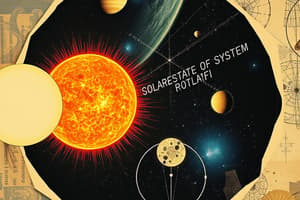Podcast
Questions and Answers
What is the approximate radius of the Sun?
What is the approximate radius of the Sun?
- 695,000 kilometers (correct)
- 432,000 miles
- 3,000,000 kilometers
- 1,000,000 miles
What is the primary process that produces energy in the Sun?
What is the primary process that produces energy in the Sun?
- Nuclear fusion (correct)
- Convection
- Radiation
- Advection
What is the approximate temperature at the top of the radiative zone?
What is the approximate temperature at the top of the radiative zone?
- 7 million Kelvin
- 2 million Kelvin (correct)
- 20 g/cm3
- 0.2 g/cm3
Flashcards are hidden until you start studying
Study Notes
- The Sun is the star at the center of the Solar System.
- It is a nearly perfect ball of hot plasma.
- The Sun radiates this energy mainly as light, ultraviolet, and infrared radiation.
- The Sun's radius is about 695,000 kilometers (432,000 miles).
- Its mass is about 330,000 times that of Earth.
- Roughly three-quarters of the Sun's mass consists of hydrogen (~73%).
- The Sun is a G-type main-sequence star (G2V).
- When hydrogen fusion in its core has diminished to the point at which the Sun is no longer in hydrostatic equilibrium, its core will undergo a marked increase in density and temperature while its outer layers expand, eventually transforming the Sun into a red giant.
- After this, it will shed its outer layers and become a dense type of cooling star known as a white dwarf.
- The enormous effect of the Sun on Earth has been recognized since prehistoric times.
- The Sun is the star at the center of the Solar System.
- The Sun is a G-type main-sequence star and makes up about 99.86% of the mass of the Solar System.
- The Sun has an absolute magnitude of +4.83 and is brighter than 85% of the stars in the Milky Way.
- The Sun is a Population I or heavy-element-rich star.
- The formation of the Sun may have been triggered by shockwaves from one or more nearby supernovae.
- The Sun rotates faster at its equator than at its poles. This differential rotation is caused by convective motion due to heat transport and the Coriolis force.
- The Sun is made of hydrogen and helium.
- The Sun's core is where nuclear fusion occurs to create energy.
- The Sun's surface temperature is much lower than its core temperature.
- The Sun will eventually become a red giant.
- The composition of the Sun's photosphere is representative of the composition of the primordial Solar System.
- The Sun's structure and fusion are affected by its rotation rate.
- The core of the Sun is the only region in the Sun that produces an appreciable amount of thermal energy through fusion.
- 99% of the power is generated within 24% of the Sun's radius, and by 30% of the radius, fusion has stopped nearly entirely.
- The remainder of the Sun is heated by this energy as it is transferred outwards through many successive layers, finally to the solar photosphere where it escapes into space through radiation (photons) or advection (massive particles).
- The fusion rate in the core is in a self-correcting equilibrium: a slightly higher rate of fusion would cause the core to heat up more and expand slightly against the weight of the outer layers, reducing the density and hence the fusion rate and correcting the perturbation; and a slightly lower rate would cause the core to cool and shrink slightly, increasing the density and increasing the fusion rate and again reverting it to its present rate.
- The radiative zone is the thickest layer of the sun, at 0.45 solar radii.
- From the core out to about 0.7 solar radii, thermal radiation is the primary means of energy transfer.
- The temperature drops from approximately 7 million to 2 million Kelvin with increasing distance from the core.
- This temperature gradient is less than the value of the adiabatic lapse rate and hence cannot drive convection, which explains why the transfer of energy through this zone is by radiation instead of thermal convection.
- Ions of hydrogen and helium emit photons, which travel only a brief distance before being reabsorbed by other ions.
- The density drops a hundredfold (from 20 g/cm3 to 0.2 g/cm3) between 0.25 solar radii and 0.7 radii, the top of the radiative zone.
- The radiative zone and the convective zone are separated by a transition layer, the tachocline.
- Presently, it is hypothesized (see Solar dynamo) that a magnetic dynamo within this layer generates the Sun's magnetic field.
- The convective zone extends from 0.7 solar radii (500,000 km) to near the surface.
Studying That Suits You
Use AI to generate personalized quizzes and flashcards to suit your learning preferences.




